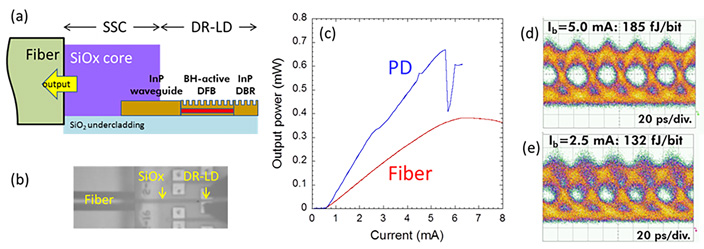Membrane Distributed-reflector LaserIntegrated with SiOx-based Spot-size Converter on Si Substrate
To meet requirements towards the new era of datacenter networks, we have proposed and realized membrane DFB lasers. Thanks to the strong optical confinement, the energy cost can be reduced to 171 fJ/bit for 25.8-Gbit/s NRZ modulation signal, which is the highest energy efficiency for DFB lasers to the best of our knowledge [1]. In addition, to obtain low-loss fiber coupling with Si high-refractive-index-difference (high-∆) waveguides, we have also developed a spot-size converter (SSC) based on a low-∆ silicon-oxide (SiOx) waveguide [2]. In this work, we achieved a further decrease of the energy cost by introducing a distributed-reflector (DR) laser structure and a reduction of fiber-coupling loss by integrating a SiOx-based SSC.
Figures 1(a) and (b) show a schematic of the device structure and a top-view image of a fabricated device, respectively. The DR laser consists of a DFB section with uniform grating, a rear DBR section, and a front InP-wire waveguide. The DFB region has a κ of 1500 cm-1 and a buried heterostructure comprising InGaAsP-based six-QW layers (150-nm thick, 50-µm long, 0.8-µm wide) embedded with 250-nm-thick InP. Both the rear DBR section and output waveguide are made of InP. A compact cavity can be achieved by employing a DBR with high reflectivity. The output InP waveguide is tapered horizontally and connected with the low-∆ SiOx waveguide via the SSC.
Figure 1(c) shows current-versus-output-power (I-L) characteristics. The curve measured by a PD set in front of the SiOx waveguide facet shows a big kink with injection current between 5 and 6 mA. This is due to the reflection at the boundary between air and the SiOx waveguide. In contrast, the curve obtained by a high-NA fiber butt-coupled to the SiOx-waveguide facet exhibits no kink thanks to the suppression of the reflection. The threshold current is 0.6 mA and the maximum output power is 0.7 mW. The fiber coupling loss is estimated to be 2.7 dB, which is 6-dB lower than our previous device. Then, we measured eye diagrams for 25.8-Gbps NRZ modulation. Figure 1(d) and (e) shows an diagram obtained with bias currents (Ib) of 5.0 and 2.5 mA, respectively. At Ib = 2.5 mA, we achieved lower an energy cost of 132 fJ/bit.
- [1] S. Matsuo et al., J. Lightwave Technol. 33, 1217 (2015).
- [2] T. Tsuchizawa et al., J. Sel. Top. Quantum Electron. 17, 516 (2011).

|
| Fig. 1. (a) Schematic device structure. (b) Top-view image of a fabricated device. (c) I-L characteristics. (d) (e) Eye diagrams for 25.8-Gbps NRZ direct modulation with Ib of 5.0 mA and 2.5 mA. |